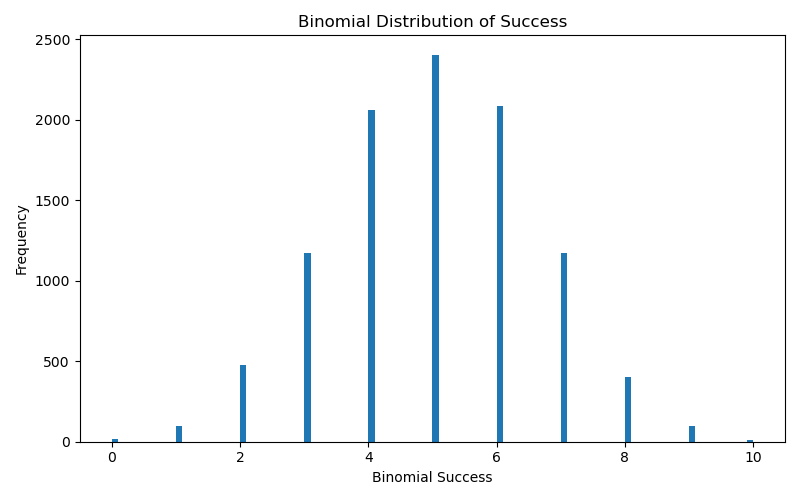Binomial Distribution
The binomail distribution models the probability of a random variable with binary sample space when an experiment is repeated n-times. For example, what is the probability of getting an even number when a dice is rolled $10$ times.
Mathematically:
$$ X \sim \beta_{p, n} $$
where:
$X$: is a random variable
$p$: probability of success
$n$: number of trials
Binomial Random Variables
As seen above, the binomial distribution takes two paraters $p$ and $n$. We can generate a binomial random variable by providing the binomial class the $p$ and $n$ parameters. Notice that generating a binomial random variable will return the total number of successes from a binomial distribution with $p$ probability and $n$ trials
from scipy.stats import binom
import matplotlib.pyplot as plt
x_binom = binom.rvs(p=.5, n=10, size=100)
x_binomVisualize the distribution plot
We can visualize the counts of successes based on the $n$ trials with $p$ probability of success over a sample of 10000. Notice that the binomial distribution converges to the expected value $5$.
x_binom = binom.rvs(p=.5, n=10, size=10000)
fig = plt.figure(figsize=(8,5))
_ = plt.hist(x_binom, bins=100)
plt.xlabel('Binomial Success')
plt.ylabel('Frequency')
plt.title('Binomial Distribution of Success')
Probability Mass Function
The probability mass function is mathematically defined as:
$$ P(x) = \binom{n}{k}(p^k)(1-p)^{n-k} $$
where:
$n$: is the number of trials
$k$: is the number of success
$p$: is the probability of
success
The above equation is the pmf given n-trials and n-success. To motivate the use of the probability mass function, let's use an example problem below.
Example Problem:
What is the probability of getting 4 out of 6 questions correct with each question
having 4 multiple choices.
From this example, we have the following information:
n = 6
k = 4
p = .25
We can calculate this is in python pretty easily using the pmf function
from scipy.special import comb
prob_4 = comb(6, 4)*(.25**4)*(.75**(6-4))
binom.pmf(k=4, n=6, p=.25), prob_4Binomial Probability Density function
The probability density function returns the cumulative probability based on the possible number of success. Below we generate the binomial distribution with success probability $p = .25$ and $n = 10$. Notice that the probability of getting 1 success is close to the probability parameter we provided and that of getting 10 success is 100% - because it is cumulative.
binom_dist = binom(n=10, p=.25)
binom_dist.cdf(1), binom_dist.cdf(10) Expected Value
The expected value for the binomial distribution is an extension of the bernuoulli with n trials: $$ \mathbb{E}(x) = np $$ We can compute the expected value using the mean function.
binom.mean(n=6, p=.25)Variance
The variance of the binom distribution is given by: $$ Var(X) = np(1-p) $$ Implementation in python:
var = 6*(.25)*(.75)
binom.var(n=6, p=.25), varStandard Deviation
The standard deviation is squareroot of the variance. Mathematically: $$ \sigma = \sqrt{np(1-p)} $$ In python, we compute the standard deviation with two methods:
import numpy as np
binom_std = np.sqrt(6*(.25)*(.75))
binom.std(n=6, p=.25), binom_std